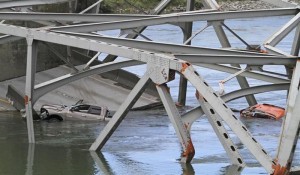Poison once flowed in America’s waters. With Trump, it might again
Peter Gleick
As a scientist working for decades on national and global water and climate challenges, I must speak out against what I see as an assault on America’s water resources.
I grew up in New York in the 1960s hearing about massive Polychlorinated Biphenyl – a toxic chemical used as a coolant – contamination in the Hudson River and the threatened extinction of bald eagles and ospreys from eating contaminated fish.
I remember watching on television Ohio’s Cuyahoga River burning. I remember scientists warning about the death of the Great Lakes and Chesapeake Bay from uncontrolled industrial pollution. I remember not being able to swim at beaches polluted with raw sewage.
And I remember the public debate and bipartisan enthusiasm for federal action to clean up our waters – enthusiasm that led to passage of one of the nation’s foundational environmental laws, the Clean Water Act, signed into law by Richard Nixon in 1972.
This law and the related federal regulations reduced water pollution and protected some of the nation’s rivers and lakes, but they are incomplete, only partially implemented, and increasingly outdated in the face of new threats from unregulated contaminants, worsening climatic changes, failing water infrastructure and direct political assault.
Donald Trump claimed he’d work to promote clean water. This claim has proven to be hollow. Since taking office, the president, administration officials, and the Republican-led Congress have moved aggressively to roll back decades of water-quality protections put in place by previous Republican and Democratic administrations.
These moves benefit industrial polluters rather than local communities, hinder progress toward cleaning up contaminated water and deteriorating ecosystems and worsen public health risks.
To address these problems, the Obama administration developed new rules to remove mercury from municipal sewage; impose limits on the amount of toxic and bioaccumulative water pollutants such as arsenic, lead, mercury, and cadmium that can be released from power plants; control previously unregulated pesticides; stop the dumping of coal wastes into streams and clarified authority for the US Environmental Protection Agency (EPA) and Army Corps of Engineers to extend protections to around 60% of the water bodies in the United States – the so-called Waters of the United States, or WOTUS, rule, also known as the Clean Water Rule.
The Trump administration and Congress have moved to rescind every one of these environmental protections.
Immediately after Trump’s inauguration, the EPA announced the agency’s intention to cancel the new regulation to cut mercury pollution in urban wastewater.
Mercury is a persistent neurotoxin affecting the brain and nervous system and scientists estimate that more than 75,000 infants in the US each year have an increased risk of learning disabilities associated with prenatal exposure to methylmercury. The largest single source of mercury contamination in urban wastewater comes from dental offices and the new rule required dental offices to install inexpensive and effective equipment to capture rather than dump mercury.
In April, EPA administrator Scott Pruitt proposed to postpone the compliance dates for meeting the new limits on toxic water pollutants from power plants. This rule would have reduced pollutant releases by 1.4bn pounds a year – including chemicals that lead to cancer and other illnesses in humans, lowered IQ in children, and deformities and reproductive damage in fish and wildlife.
The Clean Water Rule was published in June 2015 after years of scientific study, more than 400 public hearings, and literally a million public comments. It provides a critical tool for tackling persistent pollution problems from pesticides, fertilizers and industrial chemicals in water that previously lacked regulations.
Eliminating the Waters of the United States rule was an explicit objective of the Republican platform, and Trump signed an executive order in February 2017 asking the EPA and US Army Corps of Engineers to review and either rescind or revise it. In late June, the EPA announced it would move to completely replace it, removing protections from vast areas of the country.
Finally, Trump’s proposed budget imposes massive cuts to federal water-quality protections. The EPA office that develops standards for pollution in drinking water, already years behind in setting limits for unregulated pollutants, would have its budget cut in half.
The Superfund program, responsible for cleaning up severely polluted industrial sites, including many contaminating or threatening groundwater, would be cut 25% and enforcement would be cut 40%.
Programs that support environmental cleanup in Long Island Sound, Chesapeake Bay, the Great Lakes, San Francisco Bay, and other waterways would be cut to zero. The EPA’s office for scientific research and development would be cut in half.
Federal grants to states to identify and prevent leaks from underground storage tanks and programs to reduce lead exposure, like that seen recently in Flint, Michigan, would be eliminated. If we do nothing, undrinkable water could be one of Trump’s most poisonous legacies.
The good news is that Americans care enormously about clean water. The annual Gallup Poll on the environment ranks worries about water pollution above any other environmental issue, now higher than they’ve been since 2001. Scientists, public health officials, and environmental groups are also fighting back.
Lawsuits have been filed in federal court arguing that the Trump administration doesn’t have the legal authority to delay these protections, hasn’t given public notice or allowed public debate, is ignoring proven science and has acted to prioritize the interests of the coal and chemical industries over public health.
And there has been some success: in early June, in the face of a lawsuit by the Natural Resources Defense Council, the EPA agreed to let the mercury rule go forward. Some Republican members of Congress have publicly expressed concernover the severity of the proposed federal budget cuts to environmental protection.
We’ve come a long way from the era of unregulated dumping of chemicals in our streams, burning rivers, and dying ecosystems. I’m optimistic that the goal of clean, fishable, swimmable waters nationwide is achievable. But the Republican party is moving rapidly to become the party of dirty water. That’s not in their interest and it’s not in the interest of the nation. It’s time scientists and the public speak out.
Source: The Guardian.
Pure Water Gazette Fair Use Statement










